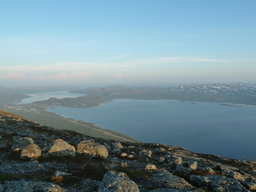10. Climate and vegetation
Climate
 Climate is a term that is used to describe the temperature and rainfall of a specific region throughout the year. Different parts of the planet have different climates. For example, the climate near the planet's equator can be described as follows: "The temperatures are warm throughout the year, and there is a lot of rainfall during all months of the year."
Climate is a term that is used to describe the temperature and rainfall of a specific region throughout the year. Different parts of the planet have different climates. For example, the climate near the planet's equator can be described as follows: "The temperatures are warm throughout the year, and there is a lot of rainfall during all months of the year."The climate of a region is influenced by the following three things:
- Its distance from the equator.
- Its distance from the sea.
- Its elevation.
How does a region's distance from the equator affect its climate?
 The closer a region is to the planet's polar regions (the South and North Poles), the colder it usually is. In areas near the planet's polar regions, the winters are especially cold.
The closer a region is to the planet's polar regions (the South and North Poles), the colder it usually is. In areas near the planet's polar regions, the winters are especially cold. The northernmost parts of Europe are located in these regions. They belong to the planet's frigid climate zone.
The island of Greenland (pictured on the right) is located in the middle of the Atlantic Ocean. It is also located far from the equator. The climate of Greenland is cold, and it is almost completely covered by a continental glacier.
How does a region's distance from the sea affect its climate?
Examine the climate diagram of London below. The names of the months are displayed by their initial letters (J = January, F = Ferbuary, etc.). The red graph displays the average monthly temperature, whereas the blue bars display the total monthly precipitation or rainfall. The temperature scale of the diagram is located on the left-hand side, whereas the precipitation scale is located on the right-hand side.
In London, the average monthly temperature is never below zero. The city receives a lot of rainfall throughout the year. This is the result of the city's temperate and rainy maritime climate.

The climate diagram of London, the United Kingdom.
The Russian capital of Moscow is located on almost the same latitude as London. However, the climates of the two cities are completely different. London's summer is much colder than Moscow's. However, Moscow's winter is much colder than London's. In other words, Moscow's climate type is continental climate.
London's maritime climate is created by the closeness of the sea. The warm ocean currents and winds blowing from the sea help to create a temperate climate with plenty of rainfall. On the other hand, Moscow's continental climate is created by the city's inland location. In areas between these climate zones, the climate has characteristics of both maritime and continental climates. This climate type is called intermediate climate.

The climate diagram of Moscow, Russia.
Average temperatures of different cities in February. The warming effect of the sea and its currents are shown in the average temperatures of Vancouver and Glasgow.
In London, the average monthly temperature is never below zero. The city receives a lot of rainfall throughout the year. This is the result of the city's temperate and rainy maritime climate.

The climate diagram of London, the United Kingdom.
The Russian capital of Moscow is located on almost the same latitude as London. However, the climates of the two cities are completely different. London's summer is much colder than Moscow's. However, Moscow's winter is much colder than London's. In other words, Moscow's climate type is continental climate.
London's maritime climate is created by the closeness of the sea. The warm ocean currents and winds blowing from the sea help to create a temperate climate with plenty of rainfall. On the other hand, Moscow's continental climate is created by the city's inland location. In areas between these climate zones, the climate has characteristics of both maritime and continental climates. This climate type is called intermediate climate.

The climate diagram of Moscow, Russia.
Average temperatures of different cities in February. The warming effect of the sea and its currents are shown in the average temperatures of Vancouver and Glasgow.
How does a region's elevation affect its climate?
 The elevation of a region also has an effect on its climate. This can be seen when climbing a mountain, for example.
The elevation of a region also has an effect on its climate. This can be seen when climbing a mountain, for example.
When climbing a mountain, the air temperature decreases by approximately 0,6 degrees Celsius per each 100 meter increase in elevation. As a result, mountain peaks experience different climatic conditions than valleys do.
This is why mountains near the otherwise warm equator can have snowy peaks.
The Kilimanjaro volcano is located in equatorial Africa. Its peak is covered by snow, as its elevation is almost six kilometers higher than that of the surrounding lowland.
Geographical zones
The planet can be divided into four geographical zones in terms of its climate. These zones are the frigid zone, the temperate zone, the subtropical zone and the tropical zone. The geographical zones change as we move from the planet's poles towards the equator.
There are different climate types inside each of the geographic zones. These variations are caused by the different geographical characteristics of various areas.
The European continent is located on three different geographical zones:
The planet's geographical zones.
There are different climate types inside each of the geographic zones. These variations are caused by the different geographical characteristics of various areas.
The European continent is located on three different geographical zones:
- The subtropical zone is found in the Mediterranean region.
- The temperate zone contains three distinct climate types: maritime climate, continental climate and intermediate climate.
- The frigid zone is characterized by cold climatic conditions.
The planet's geographical zones.
European vegetation
The vegetation of a region is largely determined by its climate type. This can be seen when studying the vegetation of the European continent.

In the frigid zone, such as on the shores of the Arctic Ocean, the climate is too cold for trees to grow. Because of this, the vegetation in these regions consists mainly of tundra. Tundra is a type of treeless vegetation characterized by grasses, shrubs, lichens and mosses.
Most of Northern Europe is dominated by coniferous forest. Coniferous forest is a vegetation type common to the colder regions of the temperate zone. It is characterized by the presence of coniferous trees, such as pine and spruce. These trees have adapted to the cold winters and brief summers of the northern latitudes.
Most of Central and Western Europe is located inside the broadleaf forest zone. Broadleaf forest is a vegetation type common to the warmer regions of the temperate zone, where there is enough rainfall and sunlight for the growth of broadleaf trees. However, most of the broadleaf forests that were once found in Central and Western Europe have been cut down and converted to agricultural use. In Eastern Europe, the dry continental climate has resulted in the formation of temperate grassland.
The Mediterranean region exists inside the subtropical climate zone. The vegetation type of the Mediterranean region is called Mediterranean vegetation. It consists of plants that have adapted to the warm climatic conditions of the area.

In the frigid zone, such as on the shores of the Arctic Ocean, the climate is too cold for trees to grow. Because of this, the vegetation in these regions consists mainly of tundra. Tundra is a type of treeless vegetation characterized by grasses, shrubs, lichens and mosses.
Most of Northern Europe is dominated by coniferous forest. Coniferous forest is a vegetation type common to the colder regions of the temperate zone. It is characterized by the presence of coniferous trees, such as pine and spruce. These trees have adapted to the cold winters and brief summers of the northern latitudes.
Most of Central and Western Europe is located inside the broadleaf forest zone. Broadleaf forest is a vegetation type common to the warmer regions of the temperate zone, where there is enough rainfall and sunlight for the growth of broadleaf trees. However, most of the broadleaf forests that were once found in Central and Western Europe have been cut down and converted to agricultural use. In Eastern Europe, the dry continental climate has resulted in the formation of temperate grassland.
The Mediterranean region exists inside the subtropical climate zone. The vegetation type of the Mediterranean region is called Mediterranean vegetation. It consists of plants that have adapted to the warm climatic conditions of the area.
Photographs from the European vegetation zones
Terminology
| Term | Explanation |
|---|---|
| climate | A term that describes the yearly temperatures and rainfall of a certain region. |
| vegetation | A term that describes the plants that grow in a certain region. |







